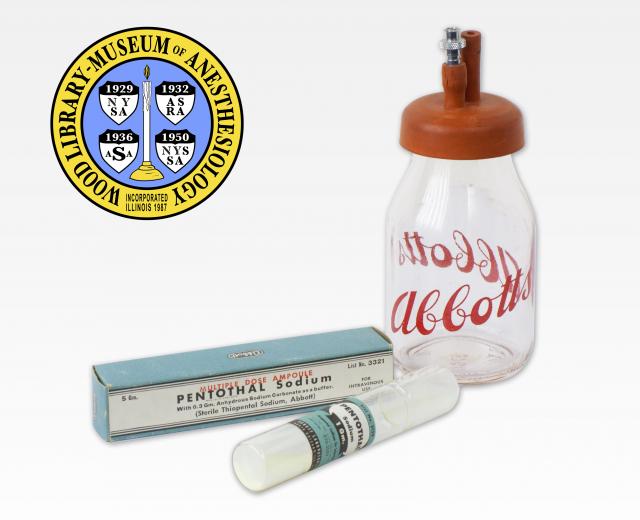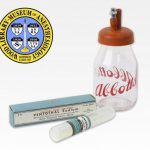Thiopental
From left to right is an Abbott Laboratories box for Pentothal Sodium, a glass ampule for Pentothal Sodium, and a glass bottle for liquid Pentothal Sodium. Pentothal Sodium is Abbott’s brand name for thiopental. Thiopental is part of a class of medications called barbiturates, which cause drowsiness and can induce sleep.
Thiopental was the first drug to be widely used as an intravenous anesthetic in the United States. Dr. John S. Lundy (1894-1973), of the Rochester, Minnesota Mayo Clinic, was the first physician to publish research on thiopental and is credited with its rapid acceptance and integration into anesthesia practice. Intravenous anesthetics are injected or infused into a vein, and they tend to work quickly. From the late 1930s through the 1950s thiopental was a popular choice for short procedures. It was also used to induce, or start, anesthesia, and augment other anesthetics. Today, although sometimes still used to induce anesthesia, thiopental has largely been replaced by a newer intravenous anesthetic called propofol.
The bottle on the right in the photograph, labeled “Abbotts,” was designed by anesthesiologists Robert D. Dripps, M.D. (1911-1973), James E. Eckenhoff, M.D. (1915-1996), and Leroy D. Vandam, M.D. (1914-2004) at the University of Pennsylvania in the 1950s.
Catalog Record: Thiopental
Three Catalog Records (aiwh, aiwg, aivy):
Access Key: aiwh
Accession No.: 2011-02-17-1
Title: Pentothal sodium / Abbott Laboratories.
Corporate Author: Abbott Laboratories.
Title variation: Alt Title
Title: Pentothal Sodium [box for ampule].
Title variation: Alt Title
Title: [Box for] Pentothal Sodium : 5 gm. multidose ampule.
Publisher: North Chicago, Ill. : Abbott Labs, [1940-1950].
Physical Description: 1 box : paperboard ; 2.5 x 13 x 2.5 cm.
Subject: Thiopental.
Subject: Anesthesia, Intravenous.
Subject: Anesthetics, Intravenous.
Subject: Drug Packaging.
Note Type: General
Notes: Title from manufacturer markings on box.
Note Type: With
Notes: With a glass ampule, package insert, and small serrated razor to score the
ampule.
Note Type: Citation
Notes: Ball C, Westhorpe R. The history of intravenous anaesthesia: the barbiturates
part 2. Anaesth Intensive Care. 2001;29(3):219.
Note Type: Citation
Notes: Hunter AR. Twenty years ago : Pentothal Sodium anaesthesia. Anaesthesia.
1968;23(3):450-457.
Note Type: Citation
Notes: Papper EM. Editorial: the fiftieth anniversary of the use of thiopentone in
man. Anaesthesia. 1984;39(6):517-519.
Note Type: Physical Description
Notes: One paperboard box for an ampule of Pentothal Sodium; The box is teal, and
white with black and white markings; Manufacturer markings are on all sides
of the outside of the box; Markings on the front of the box starting on the
left side include, “5 Gm.”; Markings on the front of the box in the center,
starting at the top, include, “MULTIPLE DOSE AMPOULE [new line] PENTOTHAL
Sodium [new line] With 0.3 Gm. Anhydrous Sodium Carbonate as a buffer. [new
line] (Sterile Thiopental Sodium, Abbott)”; Markings on the front of the box,
on the far right side include, “List No. 3321 [new line] FOR [new line]
INTRAVENOUS [new line] USE; Markings on the back of the box, from top to
bottom include, ” MULTIPLE DOSE AMPOULE [new line] Leftover solution can not
safely be allowed to stand more than [new line] a few hours. For directions
and warnings see enclosed circular. [new line] U.S. PAT. NOS. 2,153,729 AND 2
153,731 [new line] ABBOTT LABORATORIES, North Chicago, Ill., U.S.A.”; The
Abbott logo is printed on the top, bottom, and sides of the box.
Note Type: Reproduction
Notes: Photographed by Mr. William Lyle, July 28, 2010; Photographed with an Abbott
bottle for thiopental and an Abbot ampule for thiopental.
Note Type: Historical
Notes: In early 1934, John S. Lundy, M.D. (1894-1973) of the Rochester, Minnesota
Mayo Clinic, began clinical tests of Abbott Laboratories’ new barbiturate,
thiopental. Lundy was the first to publish research on the new drug. He also
created the generic name, thiopental, and is credited with its rapid
integration into anesthesia practice (Ball & Westhorpe, 2001). Abbott
Laboratories’ brand name for thiopental was Pentothal Sodium. Based on his
clinical experiences, Lundy praised the drug’s fast onset and recommended its
use for simple and short procedures (Papper, 1984). From the late 1930s
through the 1950s its uses expanded to include induction of anesthesia, and
supplementation of nitrous oxide/oxygen anesthesia, as well as regional
anesthesia (Hunter, 1968). Thiopental was also employed as the only agent for
some longer surgical procedures, but its adverse effects minimized this use.
As the first drug to be widely used as an intravenous anesthetic in the
United States, thiopental dramatically influenced the practice of anesthesia.
Today, although sometimes still used to induce anesthesia, thiopental has
largely been replaced by propofol.
Access Key: aiwg
Accession No.: 2011-02-17-2
Title: Pentothal sodium : 1 gm. / Abbott Laboratories.
Corporate Author: Abbott Laboratories.
Title variation: Alt Title
Title: Pentothal Sodium [ampule].
Publisher: North Chicago, Ill. : Abbott Labs, [1940-1950].
Physical Descript 1 ampule : glass, paper ; 12 x 2.1 cm
Subject: Thiopental.
Subject: Anesthesia, Intravenous.
Subject: Anesthetics, Intravenous.
Subject: Drug Packaging.
Note Type: General
Notes: Title from label on ampule.
Note Type: Citation
Notes: Ball C, Westhorpe R. The history of intravenous anaesthesia: the barbiturates
part 2. Anaesth Intensive Care. 2001;29(3):219.
Note Type: Citation
Notes: Hunter AR. Twenty years ago : Pentothal Sodium anaesthesia. Anaesthesia.
1968;23(3):450-457.
Note Type: Citation
Notes: Papper EM. Editorial: the fiftieth anniversary of the use of thiopentone in
man. Anaesthesia. 1984;39(6):517-519.
Note Type: Physical Description
Notes: Clear glass ampule approx. 12 cm long and 2.1 cm in diameter; The paper label
is teal, black and white with the following manufacturer’s markings, from top
to bottom: “List No. 3159 [new line] PENTOTHAL [new line] Sodium [new line] 1
Gm. [new line] Thiopental Sodium for Injection [new line, in very small font]
U.S. PAT. NOS. 2,153,729, 2,153,731 [new line] 2/F11-Lot. No. 670-3587
[“670-3587″ is stamped on the label rather than printed, new line] ABBOTT
LABORATORIES [new line] NORTH CHICAGO, ILL., U.S.A.”; The label measures
approx. 3.6 x 3.3 cm.
Note Type: Reproduction
Notes: Photographed by Mr. William Lyle, July 28, 2010; Photographed with an Abbott
bottle for thiopental and a box for a multi-dose ampule of “Pentothal Sodium”
Note Type: Historical
Notes: In early 1934, John S. Lundy, M.D. (1894-1973) of the Rochester, Minnesota
Mayo Clinic, began clinical tests of Abbott Laboratories’ new barbiturate,
thiopental. Lundy was the first to publish research on the new drug. He also
created the generic name, thiopental, and is credited with its rapid
integration into anesthesia practice (Ball & Westhorpe, 2001). Abbott
Laboratories’ brand name for thiopental was Pentothal Sodium. Based on his
clinical experiences, Lundy praised the drug’s fast onset and recommended its
use for simple and short procedures (Papper, 1984). From the late 1930s
through the 1950s its uses expanded to include induction of anesthesia, and
supplementation of nitrous oxide/oxygen anesthesia, as well as regional
anesthesia (Hunter, 1968). Thiopental was also employed as the only agent for
some longer surgical procedures, but its adverse effects minimized this use.
As the first drug to be widely used as an intravenous anesthetic in the
United States, thiopental dramatically influenced the practice of anesthesia.
Today, although sometimes still used to induce anesthesia, thiopental has
largely been replaced by propofol.
Access Key: aivy
Accession No.: 1980-02-23-1 C
Title: Abbotts [bottle for Pentothal / Robert D. Dripps, James E. Eckenhoff and Leroy D. Vandam.]
Author: Dripps, Robert Dunning, 1911-1973.
Author: Eckenhoff, James E., 1915-1996.
Author: Vandam, Leroy D. (David), 1914-2004.
Corporate Author: Abbott Laboratories.
Title variation: Alt Title
Title: Abbot bottle for Pentothal administration.
Title variation: Alt Title
Title: Abbott ‘milk bottle’ for pentothal.
Publisher: [North Chicago, Ill.]: Abbott, [1950-1960].
Physical Description: 1 bottle : glass, rubber ; 16 x 7 dia. cm.
Subject: Thiopental.
Subject: Barbiturates.
Subject: Anesthesia, Intravenous.
Subject: Anesthetics, Intravenous.
Subject: Drug Packaging.
Note Type: General
Notes: Title from manufacturer markings on bottle with descriptive terms.
Note Type: Citation
Notes: Ball C, Westhorpe R. The history of intravenous anaesthesia: the barbiturates
part 2. Anaesth Intensive Care. 2001;29(3):219.
Note Type: Citation
Notes: Hunter AR. Twenty years ago : Pentothal Sodium anaesthesia. Anaesthesia.
1968;23(3):450-457.
Note Type: Citation
Notes: Papper EM. Editorial: the fiftieth anniversary of the use of thiopentone in
man. Anaesthesia. 1984;39(6):517-519
Note Type: Physical Description
Notes: Cylindrical glass bottle, tapered at the top with a red rubber cap;
Protruding from the top center of the cap is an extension for connecting
intravenous tubing, and an extension for venting air; Marked on both sides of
the bottle in red, cursive lettering is, “Abbotts”; Markings molded into the
bottom of the bottle include, “11 [or] II [new line] 1 [or] I [approx. four
spaces] 3760 [new line] E54”; The diameter at the base of the bottle is
approx 7 cm; The diameter of the rubber cap is approx 5.5 cm.
Note Type: Reproduction
Notes: Photographed by Mr. William Lyle, July 28, 2010; Photographed with an Abbott
box and an Abbott multi-dose ampule for “Pentothal Sodium”.
Note Type: Historical
Notes: In early 1934, John S. Lundy, M.D. (1894-1973) of the Rochester, Minnesota
Mayo Clinic, began clinical tests of Abbott Laboratories’ new barbiturate,
thiopental. Lundy was the first to publish research on the new drug. He also
created the generic name, thiopental, and is credited with its rapid
integration into anesthesia practice (Ball & Westhorpe, 2001). Abbott
Laboratories’ brand name for thiopental was Pentothal Sodium. Based on his
clinical experiences, Lundy praised the drug’s fast onset and recommended its
use for simple and short procedures (Papper, 1984). From the late 1930s
through the 1950s its uses expanded to include induction of anesthesia, and
supplementation of nitrous oxide/oxygen anesthesia, as well as regional
anesthesia (Hunter, 1968). Thiopental was also employed as the only agent for
some longer surgical procedures, but its adverse effects minimized this use.
As the first drug to be widely used as an intravenous anesthetic in the
United States, thiopental dramatically influenced the practice of anesthesia.
Today, although sometimes still used to induce anesthesia, thiopental has
largely been replaced by propofol.
Note Type: Historical
Notes: Wood Library-Museum records indicate that this bottle was designed by
anesthesiologists Robert D. Dripps, M.D. (1911-1973), James E. Eckenhoff, M.D
(1915-1996), and Leroy D. Vandam, M.D. (1914-2004), at the University of
Pennsylvania in the 1950s.


